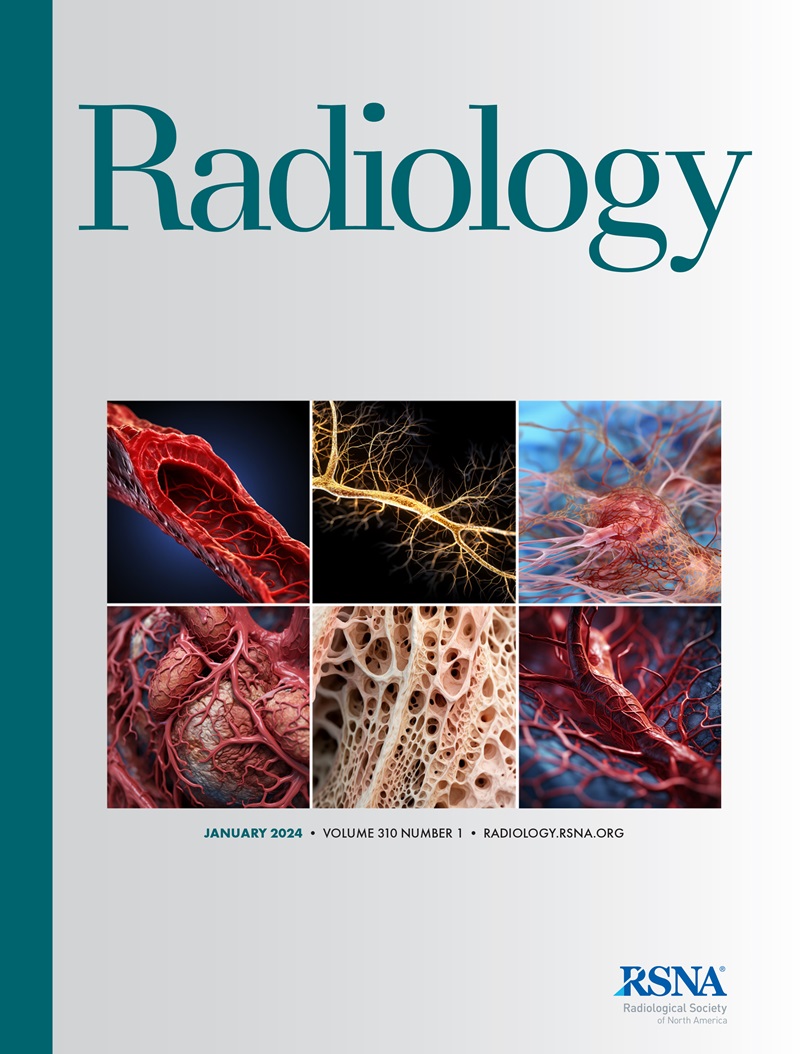Imaging Features and Diagnostic Performance of US in Nonmass Lesions with Varying Clinical Indications.
IF 15.2
1区 医学
Q1 RADIOLOGY, NUCLEAR MEDICINE & MEDICAL IMAGING
引用次数: 0
Abstract
Background The diagnostic performance of breast US for nonmass lesions (NML) is not well validated. Purpose To evaluate and compare the imaging features and diagnostic performance of US for NMLs across clinical indications. Materials and Methods This retrospective study included NMLs that underwent US-guided biopsy from January 2014 to February 2021. Lesions were also classified by their clinical indications as screening, diagnostic: work-up (DWU), or diagnostic: current breast cancer (DCBC). Logistic regression was used to identify factors associated with malignancy. The positive predictive values (PPVs) of imaging features and areas under the receiver operating characteristic curve (AUCs) of the clinical Breast Imaging Reporting and Data System (BI-RADS)-based assessments were calculated and compared between clinical indication groups using the Fisher exact or χ2 test and 2000 bootstrap samples, respectively. Results A total of 1152 NMLs in 1152 women (mean age, 47.7 years ± 11.1 [SD]) were analyzed. The malignancy rates of the screening, DWU, and DCBC subgroups were 10.4% (26 of 251), 43.4% (295 of 679), and 40.1% (89 of 222), respectively. Lesion size, hypoechogenicity, hyperechogenicity, segmental distribution, abnormal duct changes, calcifications, posterior shadowing, and the absence of multiple small cysts were the features on US images that were associated with malignancy (all P < .05), with the lowest PPVs in the screening subgroup (PPVs of screening, DWU, and DCBC subgroups: 0%-60%, 36.4%-70.7%, and 11%-100%, respectively). Clinical BI-RADS assessments showed a lower AUC in the DCBC subgroup (AUC, 0.72) compared with the screening (AUC, 0.89) and DWU (AUC, 0.88) subgroups (both P < .001). In the screening subgroup, NMLs without US features suspicious for cancer and mammographic findings had malignancy rates of 2.5%-2.7%. Within the screening, DWU, and DCBC subgroups, PPVs of US features varied by findings at mammography, symptoms, and lesion laterality, respectively (P < .05). Conclusion The PPVs of the US features of NMLs differed across clinical indications and were influenced by additional factors (mammographic findings, symptoms, and lesion laterality). AUCs of clinical BI-RADS assessments were lowest in women undergoing preoperative US for newly diagnosed current breast cancer. © RSNA, 2025 Supplemental material is available for this article. See also the editorial by Dogan in this issue.不同临床适应症的非肿块性病变的超声影像特征及诊断表现。
背景乳腺超声对非肿块性病变(NML)的诊断效果尚未得到很好的验证。目的评价和比较超声在不同临床适应症下对NMLs的影像学表现和诊断效果。材料和方法本回顾性研究包括2014年1月至2021年2月期间接受美国引导活检的NMLs。病变也根据其临床适应症分类为筛查,诊断:检查(DWU)或诊断:当前乳腺癌(DCBC)。使用逻辑回归来确定与恶性肿瘤相关的因素。计算临床乳腺影像学报告与数据系统(BI-RADS)评估的影像学特征阳性预测值(ppv)和受试者工作特征曲线下面积(aus),分别采用Fisher精确检验或χ2检验和2000个bootstrap样本进行比较。结果共分析1152例女性(平均年龄47.7岁±11.1 [SD])的nml。筛查、DWU和DCBC亚组的恶性肿瘤发生率分别为10.4%(251例中26例)、43.4%(679例中295例)和40.1%(222例中89例)。病变大小、低回声、高回声、节段性分布、导管异常改变、钙化、后影、无多发小囊肿是超声图像上与恶性相关的特征(均P < 0.05),且筛查亚组ppv最低(筛查、DWU、DCBC亚组ppv分别为0% ~ 60%、36.4% ~ 70.7%、11% ~ 100%)。临床BI-RADS评估显示,与筛查亚组(AUC, 0.89)和DWU亚组(AUC, 0.88)相比,DCBC亚组的AUC (AUC, 0.72)较低(P < 0.001)。在筛查亚组中,没有US特征的nml可疑为癌症和乳房x线检查结果,恶性肿瘤发生率为2.5%-2.7%。在筛查、DWU和DCBC亚组中,US特征的PPVs分别因乳房x光检查结果、症状和病变侧边性而异(P < 0.05)。结论NMLs的美国特征PPVs因临床适应症而异,并受其他因素(乳房x线检查结果、症状和病变侧边)的影响。临床BI-RADS评估的auc在新诊断的乳腺癌患者术前接受US的女性中最低。©RSNA, 2025本文可获得补充材料。请参阅多甘在本期的社论。
本文章由计算机程序翻译,如有差异,请以英文原文为准。
求助全文
约1分钟内获得全文
求助全文
来源期刊

Radiology
医学-核医学
CiteScore
35.20
自引率
3.00%
发文量
596
审稿时长
3.6 months
期刊介绍:
Published regularly since 1923 by the Radiological Society of North America (RSNA), Radiology has long been recognized as the authoritative reference for the most current, clinically relevant and highest quality research in the field of radiology. Each month the journal publishes approximately 240 pages of peer-reviewed original research, authoritative reviews, well-balanced commentary on significant articles, and expert opinion on new techniques and technologies.
Radiology publishes cutting edge and impactful imaging research articles in radiology and medical imaging in order to help improve human health.
 求助内容:
求助内容: 应助结果提醒方式:
应助结果提醒方式:


